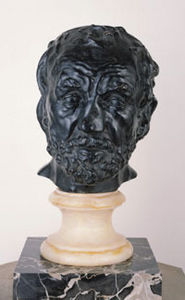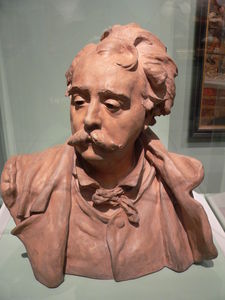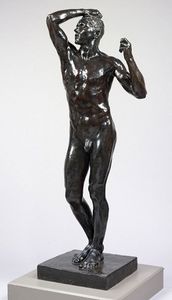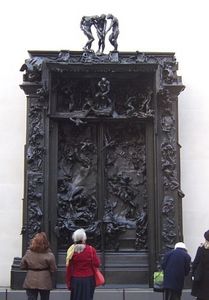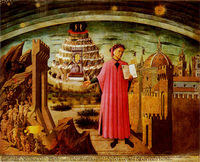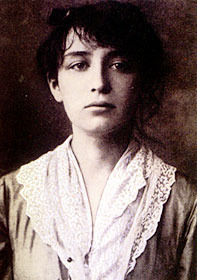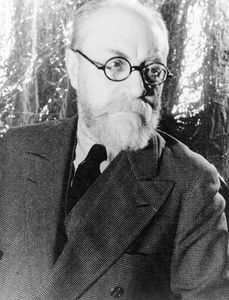Auguste Rodin Biography
- Full Name:
- Francois-Auguste-Rene Rodin
- Short Name:
- Rodin
- Date of Birth:
- 12 Nov 1840
- Date of Death:
- 17 Nov 1917
- Focus:
- Sculpture, Drawings
- Mediums:
- Metal, Clay
- Subjects:
- Figure
- Art Movement:
- Impressionism
- Hometown:
- Paris, France
- Auguste Rodin Biography Page's Content
- Early Years
- Middle Years
- Advanced Years
Auguste Rodin Early Years
-

Quick Facts
The Man with the Broken Nose would later become The Mask of the Man with the Broken Nose when the back of the head broke off, due to the freezing conditions in Rodin's studio.
Quick Facts
Partly to exonerate himself of the previous allegations, Rodin made this figure larger than
life-size.-

Albert-Ernest Carrier-Belleuse
-

François-Auguste-René Rodin was born on the 12th of November 1840 to a family of modest means in Paris, France. The second child of Jean-Baptiste Rodin and Marie Cheffer, Auguste was a shy child and was extremely nearsighted. This condition would define much of his early life and because of it Auguste Rodin failed to excel in academia. However, he immediately found a passion for drawing and had his first art lesson at the age of ten.
By 1851, in an attempt to help his son, Jean-Baptiste Rodin sent Auguste to a boarding school run by his uncle in Beauvais. After three years the young Rodin still struggled with reading and writing and instead enrolled at the École Impériale de Dessin (Paris). This art and craft school was government-funded and often known as "Petite École" or "Small School". At this time Auguste Rodin also visited museums and Gobelins tapestry workshops where he studied drawing ancient sculpture.
Here he tried working with clay for the first time and found himself to be adept at modeling and by the age of 17 he had won two prizes. However, Rodin still strived for academic acceptance and applied three times to the prestigious École des Beaux-Arts, only to be rejected each time.
Working Life:
By 1858 Auguste Rodin had begun to work commercially in order to help support his family. As many of the parks and courtyards of Paris were being transformed with monumental sculptures, Rodin had no problem finding work in the busy sculpture workshops.
Rodin's art career halted briefly in 1862 with the tragic death of his younger sister. Rodin was so grief-stricken that he joined the Catholic order, but was later encouraged to pursue art once again by Father Eymard, founder of the Holy Sacrament, who saw that life in the church was not for Auguste.
Once again enthused by the idea of being a sculptor, Rodin rented his first studio and by 1863 he was busy working on a portrait bust which he later admitted to the prestigious Salon exhibition. The Salon was famous throughout Paris and prizes there could often make or break an artist's career. The bust in question was that of Rodin's first paid model, a local handyman named Bibi.
At this time Rodin also met the women he would spend the rest of his life with, although the pair did not marry until a year before they died. Rose Beuret was a model who was extremely devoted to the artist throughout her life. In 1866 she gave birth to Rodin's only child, a son, although Auguste Rodin never formally acknowledged his paternity.
The Outbreak of War:
The Franco-Prussian war broke out in 1870 and Rodin was drafted into the army. This enlistment was short-lived however, when the 33-year-old was discharged due to his sight defect. Without work Auguste Rodin took a job with one of the commercial sculptors he had worked with for several years before by the name of Albert-Ernest Carrier-Belleuse. When his work called him to Brussels, Rodin left his mistress and young son and moved out of France for 6 years. Rodin was extremely creative in Brussels, even holding his first solo exhibit as a sculptor.
After a trip to Italy and his return to Paris in 1875, Rodin began experimenting with large-scale sculptures, inspired by the ancient models he had seen in Rome. In order to submit once again to the Paris Salon, Rodin used Auguste Neyt, a solider, as his model for his first life-size nude. The sculpture was named The Vanquished but it came under great criticism in Brussels for being so realistic and many critics believed that the artist had simply taken a cast of a human body.
Such criticism would follow Rodin for a number of years and even led to him renaming the piece The Age of Bronze but this did not remove the stigma, although the artist did receive praise for the piece's beauty at an exhibition in Paris.
Rodin then went on to create St. John the Baptist in 1880 which he later exhibited with The Age of Bronze. As one of the artist's most powerful works this sculpture certainly caught the attention of the Parisian critics but, once again, it was for the wrong reasons. Many people found this image to be improper as a nude and not depicted with the usual attributes of a leather belt, cross and scroll.
Auguste Rodin Middle Years
In 1880 Rodin received his first commission for a public sculpture from the French Ministry of Fine Arts. The commission was to produce an entrance for a new museum of decorative arts which was going to be built by the ministry. For this Rodin produced The Gates of Hell and took inspiration from Dante's Divine Comedy which was fashionable at the end of the 19th century. Unfortunately by the end of the decade the idea for the museum of decorative arts had been scrapped but the artist continued to work on The Gates of Hell for the rest of his life.
It was also during this period of Auguste Rodin's life that he began to find critical success, modeling portrait busts for Paris society. Many times such works were given as gifts of friendship by Rodin.
Work was so abundant that Rodin was able to hire assistants, several with very specific jobs. For instance, one assistant would create the plaster; another would cast bronzes while others would paint the outer surface of the complete sculptures.
Rodin met Camille Claudel while teaching a sculpture class for women and he soon fell in love with the captivating 19-year-old who shared many of his passions and was a talented sculptor herself. Influence of both artists are evident in each of their works from this period and Camille often modeled for Rodin, most notably as his inspiration for The Kiss. While Rodin and Claudel became intense lovers she eventually ended the relationship in 1898 as he would not leave his long-time companion, Rose Beuret.
One of Rodin's most experimental works was commissioned by the city of Calais in 1884 in order to commemorate the war hero Eustache de Saint-Pierre. Rodin became deeply involved in researching the story and completed the commission including six life-size men for a reasonable sum. This is yet another example of Rodin's commissioners disbanding and the work being finished by the artist for his own pleasure. The sculpture was eventually exhibited in a joint show Rodin held with the Impressionist painter Claude Monet in 1889.
Monuments of important public figures filled much of the 1880s for Rodin, including those he produced for the writer Victor Hugo and painter Claude Lorrain. However, one of the Rodin's most intense periods of production was for a sculpture commissioned by the Society of Men of Letters for the French writer Honoré de Balzac. The artist researched Balzac extensively as he had been dead for 40 years, apparently even requesting his old suits so that he could create the correct girth of the man.
After seven years and over 50 studies, some of which were more abstract, Rodin suffered one of his first professional humiliations for a number of years. The work of Balzac was finally presented in 1898 but was met with such outrage and disbelief that the society of letters refused to accept it.
Auguste Rodin Advanced Years
1900 marked the height of Rodin's success as an artist. The aristocrats of Europe paid homage to him by providing an entire pavilion dedicated to his work at the Paris World Exposition. Drawings, sketches, bronzes, marbles and plaster work were all on display making up 168 pieces in total. This exposure led to requests for work from all over the world.
It was also in this year that Rodin made his first a large-scale version of The Thinker which would go on to be one of his most well recognized works. Some critics have estimated that during this busy period Rodin employed as many as 50 assistants to work with him and he began to study dancers in order to include movement and spontaneity in his sculptures.
While his career was moving from strength to strength Rodin moved in to the Hotel Biron in 1908. Using much of the ground floor due to the very low rent Rodin was neighbor to several soon-to-be-famous creative people including the writer Jean Cocteau, painter Henri Matisse, and dancer Isadora Duncan.
Although the Hotel was due to be demolished in 1912 Rodin's influence saved the building, and in return for this favor the artist promised his estate to the French Government upon his death. Rodin lived there for the rest of his life and the hotel actually became a museum to Rodin following his death.
The artist married his long time partner Rose in 1917 only three weeks before her death. By November of the same year Rodin too had passed away and his elaborate state funeral is a testament to his status and the high regard in which he was held in Paris. The Thinker marks his grave in Meudon cemetery where Rose is buried next to him.


